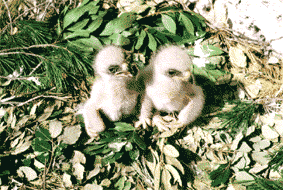|
2005,
A NOT MUCH FAVOURABLE YEAR FOR NESTING OF BONELLI’S EAGLE IN CATALUNYA Like every year the Equip d’Estudi de l'Àliga Perdiguera is making the annual control of the Catalan population of this species. The first data collected in the sample of controlled territories this nesting season indicate that the 2005 will generally be an unfavorable year for the reproduction of the eagles. This fact has been able to state specially in certain population cores of the provinces of Tarragona and Barcelona. Peculiarly, many pairs that the last years raised with regularity have failed, and in some cases nor have succeeded in laying eggs. Also is sufficiently significant the name of territories where only a chicken has been born or even where the eggs did not hatched. This fact may be caused by a large extent to the extraordinarily unfavorable climatic conditions that have occurred this year in good part of Catalan geography, with prolonged periods of fog and very intense cold during the key months of the reproduction time, and with a persistent drought that has not favored the proliferation of the populations of its main preys. These circumstances have added to others, unfortunately habitual every year, as the failure of the nesting by inconveniences of human origin or the death of some of the ancestors. It is possible to emphasize that this situation has not occurred exclusively in Catalunya. According to some data facilitated to the Equip d’Estudi de l'Àliga Perdiguera by investigators and naturalists, this situation also has repeated in some population cores of the Spanish East or the south of France. As we explain in this Web, the productivity is not the most determinant demographic parameter for the maintenance of the populations of great predators like the Bonelli’s Eagle. In addition it is normal that this parameter oscillates substantially throughout the years. Although nothing can be made to balance the climatic variability, is necessary to be kind to avoid that a tendency to the reduction of the productivity is reached in the next years. Therefore it is necessary to continue working to reduce those problems that can interfere repeatedly in the reproductive success of the eagles, in a direct way (mortality, inconveniences to the nests) or in an indirect way (viability of its habitats and the populations of its preys).
|
